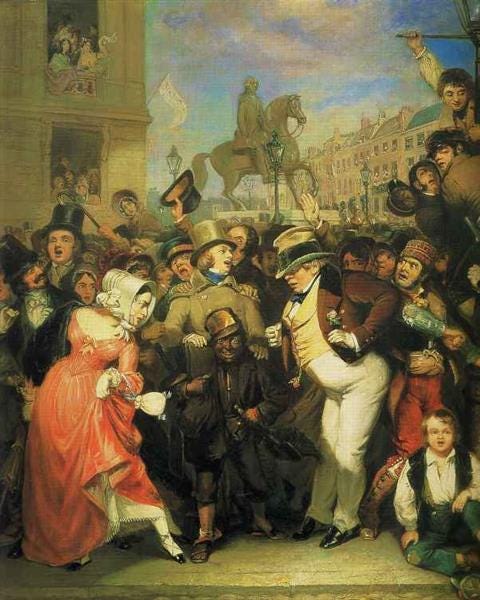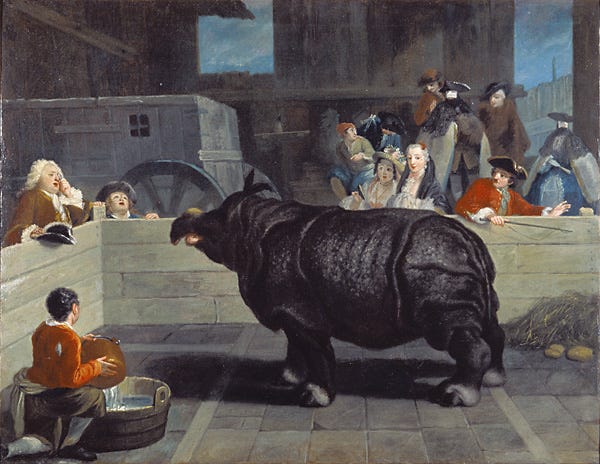Hello, my friends,
It’s always a pleasant surprise for a writer when something you wrote in the past pops into the public view once again. That happened to me a couple of weeks ago when the Medium e-newsletter featured my 2022 piece “Here’s How Librarians Choose What Goes on the Shelves”. While it’s nice that this article got a lot of attention, I feel bad for my first Medium article, “How Buildings Say Hello: Customer Service Beyond the People” (published in 2014) which sits by with an odd 53 views (the other article has around 60K). I can only shrug. Despite having published online for a long time, I haven’t untangled why some of my stuff bombs and some blows up. None of that matters for HMF, though. This is an open mic at a cozy coffee shop and for the next few minutes it’s my turn. Thank you for sticking around! Don’t forget to tip the barista.
Things Michael Likes
If you’ve been here long, you’ll have seen that I like to write the things that my kids do and like into the record with lists. Here are some things that Michael (age 4 years and 5 months) likes:
Chicken nuggets
The beach
The music of Santana. He also likes the songs of Raffi, “Little Potato” by Metamora, and John Denver’s version of “I’ve Been Working on the Railroad”), but he said the other day that Santana was his favorite. Thanks to DJ Big Mike the album Amigos is on regular rotation here.
Dinosaurs
Sting videos from the Brave Wilderness YouTube channel
Stories: He’s now old enough to sit quietly and listen to whole chapters.
Showers
Heroes (Spider Man, Superman, Hulk) and villains (Thanos, Joker, Pascal (the villain in Mini Force))
Bugs, fish, rhinos, and animals in general. Michael was pretty jazzed when I told how I held a gopher snake at a work event on Tuesday (library outreach is fun!). “Can you take me to an event with animals?” he asked. I think he yearns to hold a scorpion (another favorite beast).
Ashley. Dad is fine, but Michael’s heart still belongs to his mama.
Effective Microlearning
I’ve written about microlearning before (#15), specifically with relation to my use of the free app Kinnu to learn Positive Psychology and Ecology. The concept is also applied to language-learning apps like Duolingo, the book summary service Blinkist and other platforms that teach subjects through small modules and reinforce knowledge through spaced-repetition and usually involve elements of gamification. After using Kinnu for the past couple of months, Blinkist a few years ago, and with an understanding of how Duolingo works, I’ve concluded that microlearning apps promise way more than they deliver.
While they’re fun, there is only so much a person can master in 15 minutes a day. With Kinnu, for example, the contents of a “pathway” (their version of self-contained course) are, by my estimate, about as deep as the introductory chapter of a late high school or early college textbook. So you might spend a month completing a pathway when 1-2 hours with a textbook and some follow-up work with flash cards would have accomplished the same amount (or more) learning. It’s the same with Duolingo — can you really become fluent in a language using just the app? Highly unlikely. What you can do is master the content covered in the first few class sessions of Spanish 101, but over two or three months. To sum up: You do learn something from microlearning apps, but it’s a micro-amount!
So is microlearning a waste of time? I don’t think so. Over the past two weeks, I’ve used a microlearning app (Write it! Hebrew) for short bursts once or twice a day to memorize the Hebrew alphabet. I have a few more details to learn (vowels, for instance) but I know enough to start sounding out words, which touches my goal: Get to reading quickly on my limited time budget (understanding is later). But isn’t that the promise of microlearning apps? Learn quickly with a low time investment? Sure, but there a few key differences between them and what I did here: First of all, my goal was realistic and limited (not master Hebrew, but simply learn the letters). Second, the content isn’t a complex corpus like, say, Ecology. Third, success is easily defined (Do I recognize the letters? Can I recite them from memory? Can I write them?). End goal? I want to be able to read Jewish prayers without hunting for a transliteration. Not exactly a microlearning goal, but between microlearning techniques and a few sustained study sessions, achievable.
The Record Cabinet
I’m neither a Luddite nor am I a technophile. I read both physical books and ebooks, listen to records and Spotify, like being out in nature and playing mobile phone games. Yet, when comparing records and Spotify, for instance, there seems to be little to recommend the former. Popular music streaming services give you decent quality music, a huge selection for a reasonable cost and can go almost anywhere with you. They’re a minimalist’s dream! Still, for me the allure of the record cabinet remains: The limits of a record collection that exists without future costs in tangible space is meditative and humane. I listen to the records in my living room only (I have Ellington Indigos on as I write this). I choose from what’s in the cabinet. Dinner with old friends is a different mood than the community table. Shared stories, grooves in familiar records, a mind’s well-worn neural pathways.
It’s not logical — I can listen to the same albums on Spotify, too. Indeed, I do. But the aesthetic is somehow different. Even the knowledge that records are artificial as well, their length tied to the technology of canyons on the disc doesn’t change their appeal. Every little while, when I stand up to flip the record, I’m reminded that we’re real.








Well you know I'm going to have a comment on your last section about vinyl records, having just converted back and now rebuilding my record collection for my new turntable.
Obviously all of the things that people have already said about vinyl. That it reclaims our ability to truly appreciate music presented in an album format in the way it was originally intended. That it's more tactile, more substantive, more human. It has definitely changed. The way I listen to music. Made me more thoughtful, more mindful, more appreciative. And that's from someone for whom music is my life anyway.
But the thing that I haven't seen mentioned a lot that might be interesting here is that as somebody who struggles to reclaim my focus and attention span, I've been using the need to turn the record over as a bit of the Pomodoro Technique. The length of a record side is approximately the same amount of time that it's recommended that We focus without distraction before taking a 5 minute break. The 5 minute break is just long enough to turn and clean the next side of the album or to select a new record.
The one downside to this is it is still multitasking and it is still backgrounding music that deserves to be foregrounded. But I do plenty of that too. Baby steps.
I find if I limit my distraction only to getting up when the side of the album finishes, changing it, grabbing a new cup of tea, and returning to work, it creates a beautiful, almost monastic rhythm to my work.
The treasure available to us by spinning a piece of wax around and around... True magic.
Are you going to make me micro read fiction???